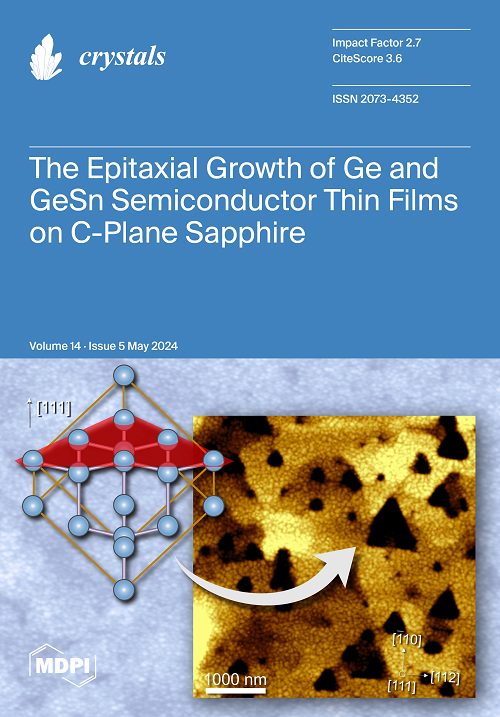Lithium Volatilization and Phase Changes during Aluminum-Doped Cubic Li6.25La3Zr2Al0.25O12 (c-LLZO) Processing
IF 2.4
4区 材料科学
Q2 CRYSTALLOGRAPHY
引用次数: 0
Abstract
Stabilized Li6.25La3Al0.25 Zr2O12 (cubic LLZO or c-LLZO) is a Li+-conducting ceramic with ionic conductivities approaching 1 mS-cm. Processing c LLZO so that it is suitable for use as a solid state electrolyte in all solid state batteries, however, is challenging due to the formation of secondary phases at elevated temperatures. The work described in this manuscript examines the formation of one such secondary phase La2Zr2O7 (LZO) formed during sintering c LLZO at 1000 °C. Specifically, spatially resolved Raman spectroscopy and X-ray Diffraction (XRD) measurements have identified gradients in Li distributions in the Li ion (Li+)-conducting ceramic Li6.25La3Al0.25 Zr2O12 (cubic LLZO or c-LLZO) created by thermal processing. Sintering c-LLZO under conditions relevant to solid state Li+ electrolyte fabrication conditions lead to Li+ loss and the formation of new phases. Specifically, sintering for 1 h at 1000 °C leads to Li+ depletion and the formation of the pyrochlore lanthanum zirconate (La2Zr2O7 or LZO), a material known to be both electronically and ionically insulating. Circular c-LLZO samples are covered on the top and bottom surfaces, exposing only the 1.6 mm-thick sample perimeter to the furnace’s ambient air. Sintered samples show a radially symmetric LZO gradient, with more LZO at the center of the pellet and considerably less LZO at the edges. This profile implies that Li+ diffusion through the material is faster than Li+ loss through volatilization, and that Li+ migration from the center of the sample to the edges is not completely reversible. These conditions lead to a net depletion of Li+ at the sample center. Findings presented in this work suggest new strategies for LLZO processing that will minimize Li+ loss during sintering, leading to a more homogeneous material with more reproducible electrochemical behavior.铝掺杂立方体 Li6.25La3Zr2Al0.25O12 (c-LLZO) 加工过程中的锂挥发和相变
稳定 Li6.25La3Al0.25Zr2O12(立方 LLZO 或 c-LLZO)是一种 Li+ 导电陶瓷,离子导电率接近 1 mS-cm。然而,要加工 c LLZO 使其适合用作所有固态电池的固态电解质是一项挑战,因为在高温下会形成次生相。本手稿中描述的工作研究了在 1000 °C 下烧结 c LLZO 时形成的一种次生相 La2Zr2O7 (LZO)。具体来说,空间分辨拉曼光谱和 X 射线衍射 (XRD) 测量确定了热加工形成的锂离子 (Li+) 导电陶瓷 Li6.25La3Al0.25Zr2O12(立方 LLZO 或 c-LLZO)中的锂分布梯度。在与固态 Li+ 电解质制造条件相关的条件下烧结 c-LLZO 会导致 Li+ 损失并形成新相。具体来说,在 1000 °C 下烧结 1 小时会导致 Li+ 损耗并形成热绿体锆酸镧(La2Zr2O7 或 LZO),这是一种已知具有电子和离子绝缘性的材料。圆形 c-LLZO 样品的顶部和底部表面被覆盖,只有 1.6 毫米厚的样品周边暴露在熔炉的环境空气中。烧结样品显示出径向对称的 LZO 梯度,颗粒中心的 LZO 较多,而边缘的 LZO 则少得多。这种分布意味着 Li+ 在材料中的扩散快于 Li+ 的挥发损失,而且 Li+ 从样品中心向边缘的迁移并非完全可逆。这些条件导致样品中心的 Li+ 出现净耗竭。这项研究结果为 LLZO 的加工提出了新的策略,可以最大限度地减少烧结过程中的 Li+ 损失,从而获得具有更高可重复性电化学行为的更均匀的材料。
本文章由计算机程序翻译,如有差异,请以英文原文为准。
求助全文
约1分钟内获得全文
求助全文
来源期刊

Crystals
CRYSTALLOGRAPHYMATERIALS SCIENCE, MULTIDIS-MATERIALS SCIENCE, MULTIDISCIPLINARY
CiteScore
4.20
自引率
11.10%
发文量
1527
审稿时长
16.12 days
期刊介绍:
Crystals (ISSN 2073-4352) is an open access journal that covers all aspects of crystalline material research. Crystals can act as a reference, and as a publication resource, to the community. It publishes reviews, regular research articles, and short communications. Our aim is to encourage scientists to publish their experimental and theoretical results in as much detail as possible. Therefore, there is no restriction on article length. Full experimental details must be provided to enable the results to be reproduced. Crystals provides a forum for the advancement of our understanding of the nucleation, growth, processing, and characterization of crystalline materials. Their mechanical, chemical, electronic, magnetic, and optical properties, and their diverse applications, are all considered to be of importance.
 求助内容:
求助内容: 应助结果提醒方式:
应助结果提醒方式:


